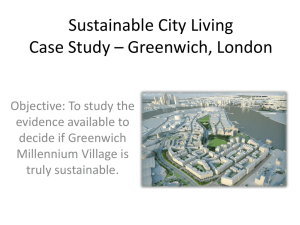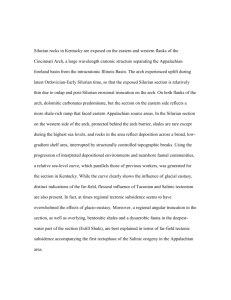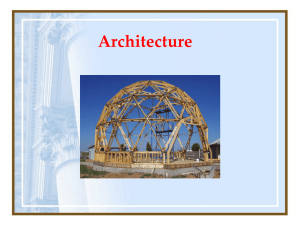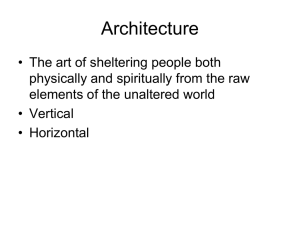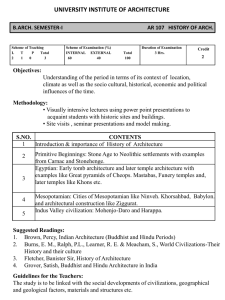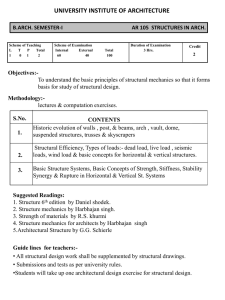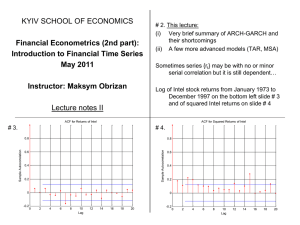mhc arch presentation - Macaulay Honors College
advertisement
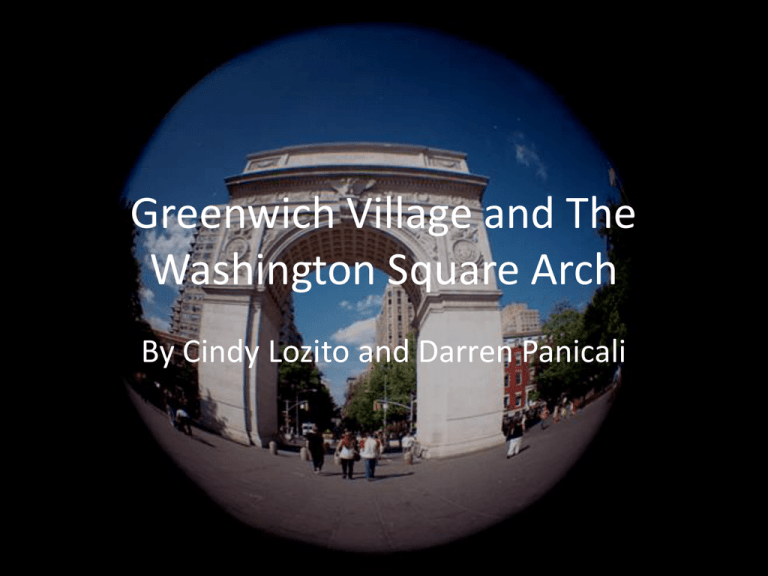
Greenwich Village and The Washington Square Arch By Cindy Lozito and Darren Panicali Overview: Exploring the Architecture and Its History in: - Greenwich Village - Washington Square Park - The Washington Square Arch Greenwich Village History The only location in New York City composed of buildings covering every decade from 1800 to the Civil War. Influenced by economics, availability of materials, and capabilities of local craftsmen and builders Originally housed craftsmen and tradespeople before expanding through migrations downtown Composed of wood structures as well as brick town houses during its early construction Architectural Styles of Greenwich Village Federal Greek Revival Italianate French Second Empire Queen Anne Federal Style (1790-1835) • Formed after the Revolution and symbolic of America’s evolving identity with political independence and freedom of design. • Takes its influence from ancient Greek and Roman temples and the Georgian colonial period • Simple with curved lines and decorative flourishes • Prominent features in an urban environment are: two stories with a basement and an attic, Flemish bond brickwork, low stoop, wrought iron railings Greek Revival (1828-1848) • A movement of national importance spreading from across the Atlantic to as far as Ohio and Indiana • Temple form and classical details of flat surfaces and millwork • Three stories high above basement, pedimented gable, wide and plain frieze, heavy cornice, iron railings embellished with castings Italianate (1850-1865) • Came to America from Italy through England • Round-arched style, details originate from Italian Renaissance villas • Most popular house style in America during the late 1860s due to modest budget adaptation and Victorian technologies’ capability to produce castiron and press-metal decorations • Brownstone veneer, four stories on basements, wide and high stoops, double doors, cast iron railings with repetitive vertical units French Second Empire (1860-1875) • As the Civil War approached, wealthy property owners attempted to reflect glories of the Paris of Napoleon III. • Died out with economic depression of the 1870s. • Very similar to Italianate architecture • Addition of the mansard roof at the top floor, richer front door paneling with frosted plate glass, enriched and more ornamental ironwork Queen Anne (1880-1893) • Architectural fashion in America when the industrial revolution brought new technology • Mass-produced pre-cut trim was formed into fanciful and lavish houses • Brick design with terra cotta ornament, curvilinear wrought ironwork, asymmetrical bay windows and cornices, architectdesigned Washington Square Park Square’s History • Previously a marsh with a brook running through • Converted to a “Potter’s Field,” or common burial ground, in 1797 • A gallows was allegedly once located there • Converted to a parade ground in 1826 • Established as a public park in 1827 • Now includes dog runs, chess tables, playgrounds, gardens, and plenty of trees • Currently under renovation; over $3 million have gone into this in the past few years Original Design vs. Current Layout From Driving Passageway to Pedestrians’ Paradise, 1971 (Thanks to Square Re-designer Robert Nichols) Some Park Architecture: The Washington Square Fountain • Aesthetic centerpiece first established in 1872 • Renovated several times like the arch • Used be closer to the southern end of the park • Now aligned with the arch closer to the north as a wading pool-style fountain Some Park Architecture: Giuseppe Garibaldi Statue • Italian hero • Exiled from Italy • Lead insurrections in the name of Italian unity/freedom • He draws his sword as if still fighting today Some Park Architecture: Alexander Holley Statue • Inventor of the Bessemer process of making steel • Revolutionized steel-using industries in America • Stone base uses Greek details And Finally: The Washington Square Arch Historical Context of the Arch • Finished and celebrated on April 30, 1889, in honor of the centennial of Washington’s inauguration and erected as a permanent memorial to him. • Originally made of wood and stucco but redone in marble in 1891 • Architects: Charles McKim, William Mead, and Stanford White. (They were also famous in helping to design Penn Station, Madison Square Garden, the Municipal Building, the Harvard Club, and the Metropolitan Museum of Art, among many other buildings.) Historical Context of the Arch (cont’d) • Skeletal remains found during excavation for the piers; hinted at burial grounds • With the transition of driving to walking under the arch, it became a welcoming symbol for people, inviting leisurely walking and marveling at the arch’s sheer grandeur. • Original arch was 77 feet tall, but marble version stands at 72 ½ feet. • Eroded by time, weather, corrosion, and animals, so in 2004, it was renovated for $2.7 million. • Inscription at top reads: “Let us raise a standard to which the wise and the honest can repair. The event is in the hand of God. — Washington” Original Arch vs. Current Arch Influence of the Beaux-Arts Arc de Triumphe from Paris Beaux-arts is a form of eclectic neo-classicism that displays the following: Enormous size Immense Archways Stone material Symmetry Lavish relief decorations Extraordinary detail with classical influences Naturalism in sculpture Bas Relief • Insignias and other designs are etched into the stone but don’t jut off of it Coffered Ceiling • Decorated, amazingly symmetrical squares worked into the stone Console bracket keystones • Scroll-shaped (“console”) • Located at apex of arch as a keystone • Keeps parts in position as a bracket Frieze: Alternating Wreaths • Frieze – Wall, often decorated, above columns/piers • Patterned with wreaths; every other has a star inside • Wreaths connected by olive branches and W’s Washington’s Likenesses Washington as Commander-in-Chief, Accompanied by Fame and Valor by Hermon MacNeil. Erected in 1916. • Displays dualism of Washington, as a man of both war and peace, whichever is appropriate; he always knew which one was. • Invokes realist influences Washington as President, Accompanied by Wisdom and Justice by Alexander Stirling Calder. Erected in 1918. Bibliography for Information and Images • • • • • • • • • http://www.nycgovparks.org/parks/wa shingtonsquarepark/highlights/6537 http://www.nycgovparks.org/downloa d/download.php?downloadFile=WSP_E • AS/appendix_3.pdf http://www.nyc• architecture.com/SPEC/GAL-GVWASH.htm http://www.parisrenaissance.com/pari • s_attractions/arc_de_triomphe.cfm http://gawker.com/5261620/thefountains-youth • http://www.bridgeandtunnelclub.com/ bigmap/manhattan/villages/greenwich • /washingtonsquarepark/index.htm http://www.nycgovparks.org/parks/wa shingtonsquarepark/highlights/9754 http://architecture.about.com/od/peri odsstyles/ig/Historic-Styles/BeauxArts.-0cU.htm Landmarks Preservation Commission. Greenwich Village Historic District Designation Report. Vol. 1. New York: City of New York, 1969. Print. http://architecture.about.com/od/peri odsstyles/ig/House-Styles/Federal.htm http://architecture.about.com/od/peri odsstyles/ig/House-Styles/saratoga-jc3180005.htm http://architecture.about.com/od/peri odsstyles/ig/HouseStyles/Italianate.htm http://rowhouser.com/index.php?/site /C8/ http://www.flickr.com/photos/2926157 9@N04/3574353039/ THE END.

